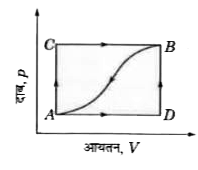The direct conversion of A to B is difficult, hence it is carried out by the following shown path A→C→D→B. Given ΔSA→C= 50 eu, ΔSC→D= 30 eu, ΔSB→D= 20euSolution in Telugu
+100 eu
+60 eu
−100 eu
−60 eu
The correct Answer is:B
ΔStotal=ΔSA→C+ΔSC→D+ΔSD→B
=50+30−20=60
Topper's Solved these Questions
- BOOK - AAKASH SERIESCHAPTER - CHEMICAL THERMODYNAMICSEXERCISE - LECTURE SHEET (EXERCISE-III) (LEVEL - II (ADVANCED) STARAIGHT OBJECTICE TYPE QUESTIONS)12videos
CHEMICAL THERMODYNAMICS
- BOOK - AAKASH SERIESCHAPTER - CHEMICAL THERMODYNAMICSEXERCISE - LECTURE SHEET (EXERCISE-III) (LEVEL - II (ADVANCED) MORE THAN ONE CORRECT ANSWER TYPE QUESTIONS)5videos
CHEMICAL THERMODYNAMICS
- BOOK - AAKASH SERIESCHAPTER - CHEMICAL THERMODYNAMICSEXERCISE - LECTURE SHEET (EXERCISE-II) (LEVEL - I(MAIN) INTEGER TYPE QUESTIONS)6videos
CHEMICAL THERMODYNAMICS
- BOOK - AAKASH SERIESCHAPTER - CHEMICAL THERMODYANMICS EXERCISE - Questions For Descriptive Answers28videos
CHEMICAL THERMODYANMICS
- BOOK - AAKASH SERIESCHAPTER - ELECTRON MIGRATION EFFECTS EXERCISE - QUESTIONS FOR DESCRIPTIVE ANSWERS10videos
ELECTRON MIGRATION EFFECTS
Similar Questions
What are the sign of the entropy change (+ or -) in the following:
I : A liquid crystallises into a solid
II: Temperature of a crystalline solid is raised from 0K to 115K
III: 2NaHCO3(g)→Na2CO3(g)+CO2(g)+H2O(g)
IV : H2(g)→2H(g)01:51View SolutionAll the antural processes in this universe produce
02:34View SolutionWhat is the difference between heats of reaction at constant volume and constant pressure for the reaction N2(g)+O2(g)→2NO(g)
01:49View SolutionHow does heat of neutralisation value change with the chemical nature of acid and base?
01:57View SolutionHyperconjugation effect is also termed as 'no bond resonance'. Why?
04:10View SolutionThe direct conversion of A to B is difficult, hence it is carried out as A rarr C rarrD rarr B Given, DeltaS_((A^rarrC)) = 50 eU,DeltaS_((C^rarrD))=30eU,DeltaS_((BrarrD))=20 eU , where eU is entropy unit. Thus the change in entropy in (A rarrB) is:
01:54View SolutionFor the following metals A, B, C, D react with each other : (NR = No reaction) {:(A+B^(+)rarr NR,,B+C^(+) rarr NR),(B+D^(+) rarr B^(+)+D,,C+D^(+) rarr C^(+)+D),(A^(+)+C rarr C^(+)+A,,D+A^(+) rarr D^(+)+A):} Which is the order of the metals in increasing reducing strength?
01:56View SolutionThe conversion A to B is carried out by the following path : C→D↑ ↓A B Given : ΔS(A→C)=50 e.u. ,
ΔS(C→D)=30 e.u., ΔS(B→D)=20 e.u.
where w.u. is entropy unit then ΔS(A→B) is01:31View SolutionThe direct conversion of A to B is difficult. Hence, it is carried out by the following shown path : DeltaS_((A rarr C)) =50 e.u., DeltaS _((C rarr D)) = 30 e.u. DeltaS_((BrarrD)) = 20 e.u. where e.u. is entropy unit, then DeltaS _((A rarr B )) is
03:22View SolutionGiven the following reaction involving A,B,C and D
(i) C+B+→C++B
(ii) A−+D→ NO reaction
(iii) C++A→ NO reaction
(iv) D+B+→D++B
the correct arrangement of A,B,C,D in the order of their decreasing ability as reducing agent03:40View SolutionThe direct conversion of A or B is difficult, hence it is carried out by the following shown path
Given, ΔSA→C=50eu, ΔSC→D=30eu,ΔSB→D=20eu

Where eu is entropy unit, then ΔSA→B is .04:00View SolutionA का B में सीधा परिवर्तन बहुत कठिन है। अतः इस परिवर्तन को निम्न प्रकार किया जाता है
दिया है
ΔSA→C=50eu,ΔSC→D=30eu,ΔSB→D=20eu
जहाँ, eu एन्ट्रॉपी की इकाई है। यहाँ ΔSA→B होगा02:35View SolutionThe direct conversion of A to B is difficult, hence it is carried out by the following shown path A→C→D→B. Given ΔSA→C= 50 eu, ΔSC→D= 30 eu, ΔSB→D= 20eu
02:02View SolutionA का B में सीधा परिवर्तन बहुत कठिन है। अतः इस परिवर्तन को निम्न प्रकार किया जाता है
 दिया है,
दिया है,
ΔS(A→C)=50eu
ΔS(C→D)=30eu
ΔS(B→D)=20eu
जहाँ, eu एन्ट्रॉपी की इकाई है। यहाँ ΔS(A→B) होगा02:12View SolutionIn the decay process: A overset(- alpha)rarr B overset(-beta)rarr C overset(-beta)rarr D a) A and B are isodiaphers b) A and C are isotones c) A and C are isotopes d) B, C and D are isobars
02:01View SolutionThe conversion of A into B follows Has been given : DeltaS_((AtoC))=50" e.u."),DeltaS_((CtoD))=30" e.u.",DeltaS_((BtoD))=20" e.u." Where eu is the entropy unit DeltaS_((AtoB)) is
04:44View Solution

